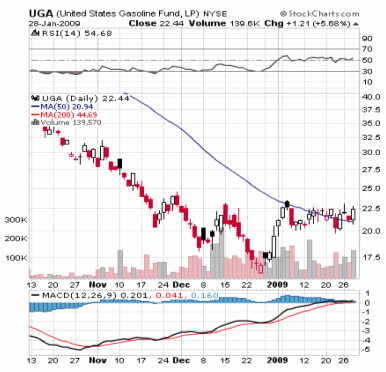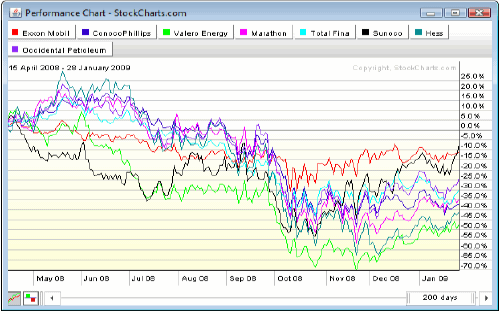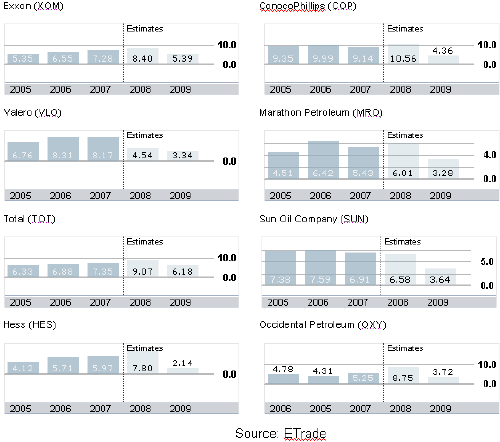By Guest Author: Robert Williams, PhD, P.E.
Are gasoline prices headed higher? It’s very probable if you consider the previous 2008 history, the fact that OPEC is announcing that they are cutting crude oil production and refiners have to start producing the summer month’s gasoline inventories. When will the unleaded gasoline prices increase further is an educated guess based on the UGA ETF chart shown below. UGA prices appear to have tested the resistance level a number of times. A UGA quote at time of writing is $23.10 up 3% with almost twice the daily volume. Could this be the chart breakout that will lead to higher prices? Time will tell.
This is the unleaded gasoline price dilemma – if we buy UGA on the breakout and the price keeps going up then you will have a good return on your investment. But, you will also be paying much more at your local gas station to fill up your gas guzzling SUV which
you still have not exchanged for a hybrid (or have you?). Depending on how much you are willing to invest in UGA and how much gasoline you consume this could be a break even investment for you, i.e. you could hedge your gasoline purchasing.
My personal preference is that we do not get to experience the 2008 gasoline price escalation.
However, as I am employed in the oil & gas industry, it would be beneficial in the long term for an increase in the current crude oil prices since major refiners have cutback on major project investments or delayed current projects due to the drastic cutback in their cash flow. Projects well advanced in their engineering, design and construction phase have not been impacted but other projects have had their schedules extended or put on the back burner indefinitely. However, if crude prices come anywhere close to 2008 levels, the global economic impact could be substantial. Therefore, it’s wrong to wish for that to. That is the dilemma.
In order to process heavy crude oil from Canada there are a number of current refinery projects to add coker and sulfur plants to existing refineries, both in Northern and Southern States. Coker plants process the heavy oils and produce coke allowing for expanded refinery gasoline production. Sulfur plants remove the sulfur pollutants and produce raw sulfur which is also marketed. Such major projects are 4 to 6 years in duration and some are currently installed, others are in construction and still others are in the detailed engineering/planning phase. The latter projects are suffering project schedule delays due to the large drop in the 2008 crude oil prices causing revised refinery cash flow projections.
The following StockCharts comparison of major refiners’ 9-month chart shows that they all have followed a similar pattern. With a detailed review of individual daily charts you may consider that breakouts are imminent in one or more of these major oil companies. Earnings are also displayed for your perusal and evaluation as to which to potentially invest in.
Major Refiners Earnings Estimates
Author Bio:
Robert Williams 40 plus years experience includes oil/gas engineering in crude oil/petroleum products/natural gas, refining, processing and pipelines on all continents, except South America and Antarctica, from Alaska and Australia pipelines to S.E. Asia offshore, from UK North Sea to Los Angeles fuel truck racks and from Romanian pipelines to West Africa FPSO.



Thanks for your post Robert. I’d like to add that the credit crisis along with cheap gasoline sets us up for a dangerous situation down the road. With exploration and renewable energy projects slowing along with the general public likely easing back into their gas guzzling habits, the price of crude will likely skyrocket once the global economy picks up again. The government must fund renewable energy projects on a large scale and do it now while there is still time. This isn’t the 70’s. . the growth of India, China and Brazil didn’t exist back then. It’s no longer just the US that’s thirsty for oil.